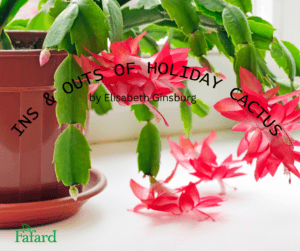
What is the difference between a Thanksgiving cactus and a Christmas cactus? Inquiring, plant-loving minds want to know. Also, are those seasonal bloomers the same as Easter cacti? Do they all require the same care and culture? Confusion seems to abound in the world of flowering holiday cacti. Lots of people have them, but not everyone knows the answers to those pertinent questions.
Holiday Cactus Basics
Let’s start with the obvious. All holiday cacti are houseplants with segmented, succulent leaves, arching stems, and, in certain seasons, brightly colored flowers at the ends of the stems. They owe their popularity to the fact that they are relatively undemanding plants that can live for years under the right conditions. Thanksgiving and Christmas cacti have the added benefit of producing bright flowers during the dark months.
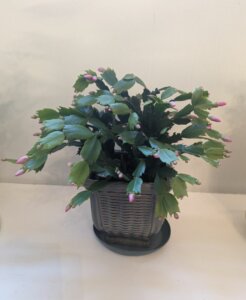
Thanksgiving and Christmas cacti, sometimes billed as “zygocactus”, are both members of the genus Schlumbergera, named for Frederick Schlumberger, a nineteenth century botanist. Thanksgiving cactus is a species (Schlumbergera truncata), while Christmas cactus (Schlumbergera x buckleyi) is a hybrid, with the truncata species in its ancestry. Some of the most popular holiday cacti, including the Christmas cactus (Schlumbergera x buckleyi), are hybrids, which may further complicate identification.
Giving Thanks for Bright Blooms
Thanksgiving cacti hail from tropical Brazilian rainforests where the species grows epiphytically on trees. The Thanksgiving plants are distinct from other holiday cacti by the fact that their flat, segmented leaves, which end in points, making them appear a bit clawlike. This trait gave rise to one of the species’ nicknames, “crab cactus”. Another distinguishing feature is the pollen, which is yellow. Container-grown specimens grow from one to two feet tall and can spread up to two feet. Most selections sold in stores at holiday time are somewhat smaller, but a happy plant will bulk up as the years go by.
Thanksgiving cactus generally bloom in November or December, just in time for the Thanksgiving holiday, with flowers in shades of white, pink, peach, orange or yellow.
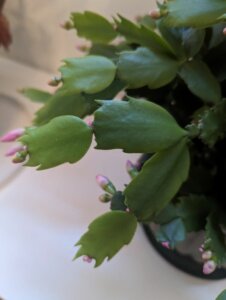
Christmas Cactus
Like Thanksgiving cactus, Christmas cactus bears segmented stems, but instead of the “claws” at the ends of the segments, the edges are more rounded—with a slight teardrop-shape. Christmas cactus also features pink pollen, borne by the stamens within the flowers, which are traditionally reddish-purple. The plants are roughly the same size and configuration as Thanksgiving cactus, but bloom a bit later, usually from the end of December, through January. The species name, buckleyi, comes from a nineteenth century English hybridizer, William Buckley.
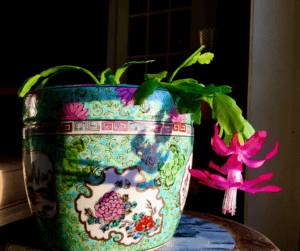
Hybrids Gone Wild
Plant breeders always latch onto good things, and that is especially true with hybrid Schlumbergeras, which are often simply labeled “holiday cactus”. Their work has extended the color range, increased flower size and shape, and created hardier plants. A good example is ‘Aspen’, with broad, white, frilly petals accented by pink rings in the flowers’ throats. ‘Chiba Spot’ is ‘Aspen’s opposite, with extremely slender petals in orange-red. ‘Limelight Dancer’ blooms in an unusual color–pale yellow with green overtones—and sports contrasting pinkish pistils. The amount of variety in the Schlumbergera world seems to increase each year.
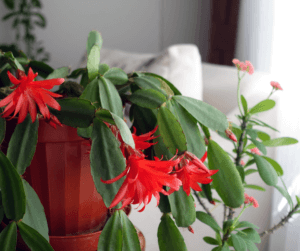
And What About Easter Cactus?
Easter cactus, while related to the holiday cacti is not a Schlumbergera, but a Rhipsalidopsis, specifically Rhipsalidopsis gaertneri. It is a little less popular and a little more finicky than either Thanksgiving or Christmas cactus, being quite sensitive to both over and under-watering. The flattened leaf segments are the same, but are somewhat scalloped. The flowers are brilliant red, but with shorter tubes than those of the holiday cactus.

Cactus Care
All three holiday cacti like excellent drainage—ideally orchid mix or potting mix lightened with organic matter, like Fafard® Premium Natural and Organic Compost, and perlite. Indoors the plants thrive best with bright, indirect light. To stimulate blooming, night temperatures should be between 55 and 65 degrees Fahrenheit. Water sparingly when the top of the soil feels dry to the touch, Easter cacti like higher humidity, either through regular misting, a room humidifier or a position atop a tray filled with pebbles and water.
Holiday cacti appreciate an outdoor summer vacation in a lightly shaded spot, as long as that spot doesn’t get swamped in rainstorms. Bring the plants in when night temperatures start to drop below 55 degrees Fahrenheit and days begin to shorten. After the outdoor vacation, Thanksgiving cacti will frequently start to show color on the stem tips, a prelude to bud formation and blooming. Christmas cactus will not be far behind.
With good care, the plants will survive and rebloom for years to come.


